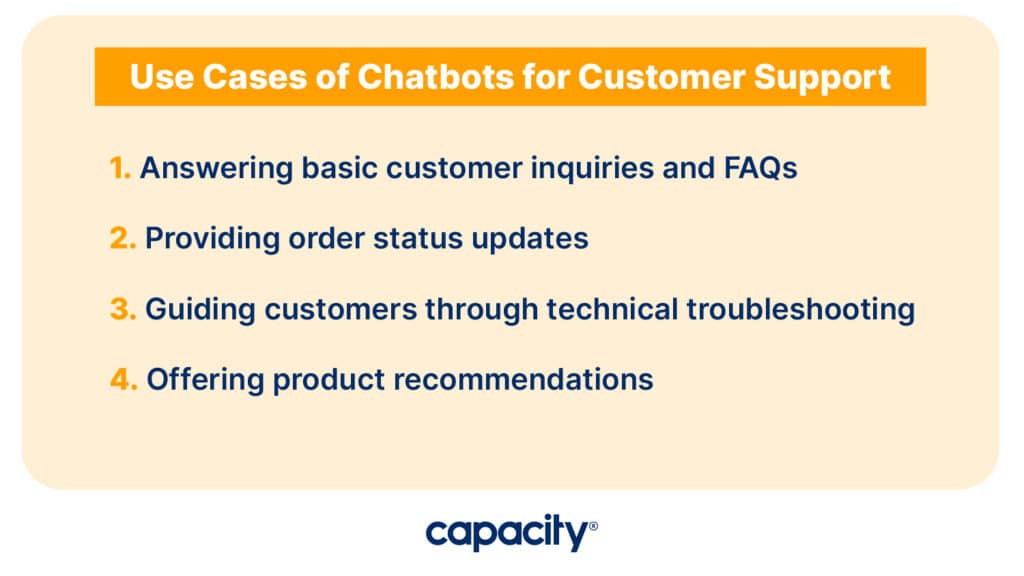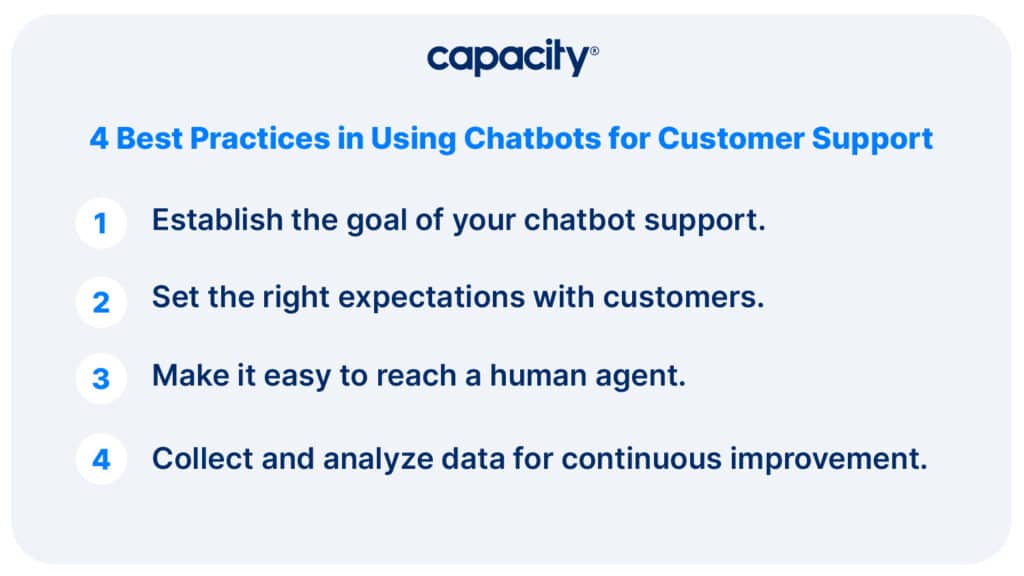With AI-powered chatbots, chatbot support has become an increasingly popular tool for businesses. Why? Because chatbots improve service operations and customer experience. And a better customer service experience is worth the investment. In fact, according to Bain & Company, businesses can grow revenues between 4% and 8% when prioritizing better customer service experiences.

Bots can engage with customers 24/7, providing a convenient and efficient way to handle common inquiries, support tickets, and even sales inquiries. Chatbot support is also incredibly versatile. Bots can integrate with various messaging platforms, social media channels, and websites, making omnichannel support simple.
Chatbot support enhances your customer experience and streamlines your operations – no matter the size of your brand. Let’s explore how.
What is chatbot support?
Chatbots are AI-powered conversational robots that can respond proactively to messages from customers. Using natural language processing and machine learning, chatbots analyze an incoming message. They then gather an understanding to provide an appropriate conversational response in real time. Chatbot support uses this technology as a form of customer support. Your team can engage customers using automated tailored messages — instantly.
This style of support is revolutionizing the customer service industry. One report notes that AI chatbots handle up to 85% of customer service interactions. And as many as 88% of consumers had at least one conversation with a chatbot in 2022. Yes, it may feel strange and impersonal to talk with a robot. (We’ve all watched enough dystopian sci-fi movies to feel some anxiety about AI and robots). But chatbot support has many benefits. Let me convince you why they’re worth the investment.
The benefits of using chatbots for customer support
We’re only beginning to understand how automation and chatbots can help us. Sure, we’ve all gotten used to asking Siri or Alexa about tomorrow’s weather or the current NBA playoff game’s score. But we’re just skimming the surface. The benefits of chatbots are endless, especially in customer service. With chatbots, businesses can save time, grow revenue, and increase customer satisfaction — all at once. No, seriously.
By automating routine tasks and inquiries, you can help more customers faster, accurately, and at all hours of the day. Chatbot support is an efficient and cost-effective way to provide customer service. Let’s see how chatbot support benefits your business:

Cost Savings
Chatbots are an easy way to reduce costs in your contact center. Support teams are, more often than not, overwhelmed with a high volume of incoming customer requests and inquiries. As a result, the industry is plagued with high turnover rates, absenteeism, and burnout. In the end, retaining support reps and keeping employees engaged is costly. It’s tough to keep up.
But with chatbot support, you can cut costs by deflecting work to bots. Chatbots reduce the need for human agents by handling routine inquiries and tasks. This means you can scale back your staffing needs and save on labor costs.
Plus, a bot is available 24/7. Customers can be supported, or at least receive a response from your company, at any hour of the day. And, without battling as much turnover, you can focus on hiring and retaining better talent so customers with more complicated issues have the best possible help from your team.
Quick and efficient response time
We’re in an age of support where any time you ask customers to wait, you’re risking customer satisfaction. Customers have gotten used to instant gratification. So shorter wait times and shorter resolution times should be the goal. Chatbot support allows you to offer a fantastic customer experience by providing immediate service to customers. Use chatbot support to answer customers’ basic inquiries. Or point them toward useful self-service tools already in your knowledge base.
Chatbots alleviate your service agents from performing repetitive tasks. They can handle scheduling appointments, sending reminders, or collecting customer feedback. Then, if a conversation becomes more intricate for the bot, it will seamlessly transfer to human support agents. All without skipping a beat! With chatbots deflecting common customer queries, your human agents have time to handle higher-value customer issues. Your agents will tackle the more complicated matters faster and easier than ever before.
Data collection and analysis
Chatbots can also help you collect valuable customer data. Using natural language processing, chatbots can understand customer inquiries and preferences. They can then collect data from those inquiries to improve customer experiences.
Chatbots can also collect customer information like contact information, order history, and feedback. This data helps identify patterns and trends in customer behavior. With that information, you can improve your products, services, and customer support.
Use cases of chatbots for customer support
If you add chatbot support to your organization, you need clear use cases. What are the most effective and productive ways to use chatbots to save time, money, and resources?
Here are four use cases for using chatbots for customer support:

Answering basic customer inquiries and FAQs
As mentioned, chatbot support is a great way to help customers quickly. Chatbots can answer incoming questions and direct customers to self-service tools within minutes.
Providing order status updates
Move away from reacting to customers and provide more proactive support using chatbots. With chatbot support, automate order statuses or product updates to customers. Give your customers all the info they need, so they don’t even need to reach out to you quite as often.
Guiding customers through technical troubleshooting
It’s true – chatbots can’t provide customers with the human touch necessary for long-term customer loyalty and relationships. But they’re great at giving customers the facts. Often customers just need the right technical steps to resolve an issue. Drafting a troubleshooting guide via email or text or talking a customer through an issue on the phone is incredibly time-consuming. With chatbot support, bots can walk customers through the first technical troubleshooting steps. This support will inevitably lower the volume of problems your human agents need to solve, leaving only the complicated issues to them.
Offering product recommendations
Chatbots can give customers personalized recommendations by analyzing customer behavior within your product or website. Using customer history and the context of the conversation, chatbot support can recommend products to your customers to help them fulfill their needs (and help you boost sales!).
Best practices in using chatbots for customer support
Ready to add chatbot support to your customer service strategy? Here are some best practices to follow for success.

Establish the goal of your chatbot support
To get the full benefit of your chatbot support, you have to set clear goals and objectives before implementation. A poorly set up chatbot could even damage your customer relationship.
Before going live, consider some of the following questions to guide your goal-setting:
- What is hindering our customers from having a good experience?
- What problems within our contact center are we hoping to solve? (Resolution time, customer satisfaction, lead collection, etc.)
- What are the questions and issues that customers most often reach out about?
- Do we have self-service tools for the chatbot to share with customers?
- How can we be proactive with customers using chatbot support?
- How will we gather customer information?
- At what point do we route a customer from a chatbot to a human agent?
Set the right expectations with customers
Because it offers convenience, many customers will have no problem working with a chatbot. But you need to be transparent with customers to let them know they’re interacting with a bot. To be transparent, be sure your chatbot support:
- Sets expectations: Customers know they’re not speaking with a human, so they won’t expect certain things.
- Promotes acceptance and trust: Shows that you’re not hiding anything from customers.
- Provides transparency: Customers are open to communicating with bots but don’t want businesses to deceive them.
Make it easy to reach a human agent
Chatbots aren’t meant to resolve every issue. You have capable support reps who will need to take over sometimes. For the best customer experience, make it possible (and easy) for a customer to jump from a conversation with a bot to a conversation with one of your human agents. Ensure your bot can pass on the customer context and conversation history to agents. They’ll need all the details so customers don’t have to repeat themselves.
Collect and analyze data for continuous improvement
Collect data, analyze, and measure for improvement to ensure your bot is the most successful. Chatbot support is a worthwhile investment, but you’ll need to do some digging to ensure it’s working well. Consider tracking some of the following metrics and KPIs to see how well your chatbot is doing. Measure:
- Customer satisfaction: This metric measures how customers are with the chatbot support they receive. A high customer satisfaction rate indicates that chatbots are meeting customer needs effectively.
- Response time: This KPI measures how quickly chatbots respond to customer inquiries. Specifically, it calculates the time between a customer request and the chatbot’s response. A lower response time means that customers receive faster service.
- Ticket volume: This metric measures the number of customer support tickets that chatbots handle. A higher ticket volume means that chatbots are helping to reduce the workload of human support agents.
Then, ask customers directly! Use your chatbot to send follow-up surveys to customers to give them a chance to give feedback. See what customers think of their experience with the bot to drive better customer satisfaction over time.
Want to try your own chatbot? Try Capacity for free to see how chatbot support can drive efficiency for your team.





